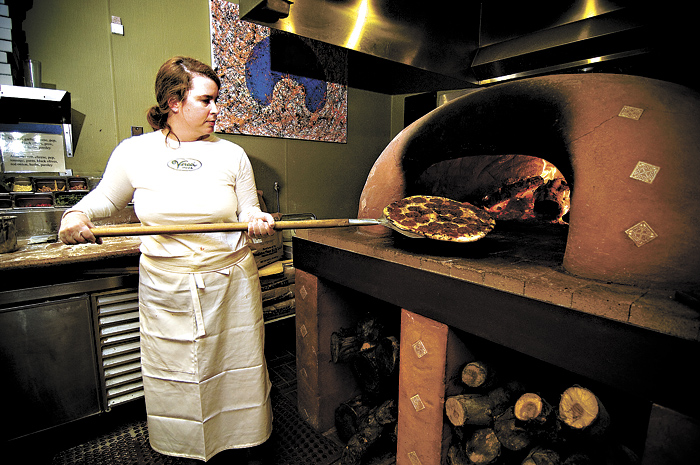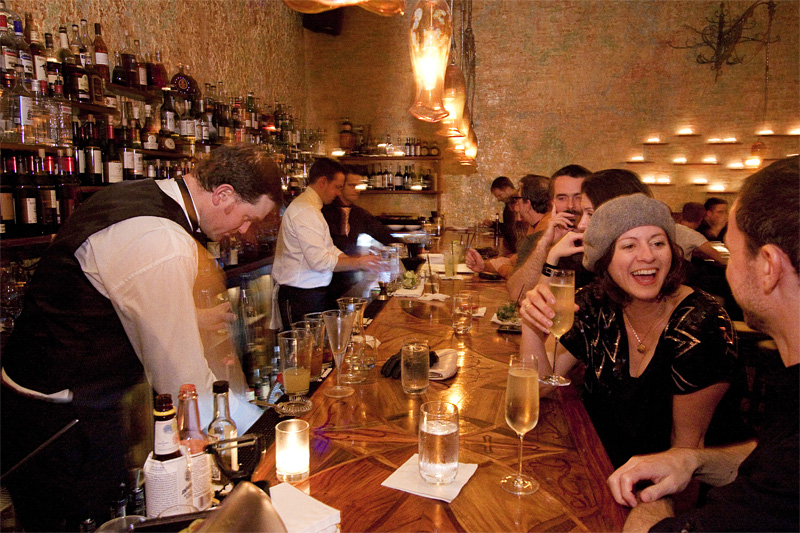Pump the stomach of your average Seattleite and you’d probably find the swill contains 10 percent local/organic/sustainable produce, 40 percent mood-altering liquids, and 20 percent cheese and tomato sauce.
In Ballard, the pizza density has become comical. Let me just rattle off a few of the established joints with N.W. addresses: Madame K’s, Pagliacci, Soprano’s, Crash Landing, Snoose Junction, Zayda Buddy’s, Palermo—and I’m not even mentioning the national franchises. Add to this impressive list three new pizza restaurants that have opened up in the past few months and you begin to wonder if the market can ever be saturated. More important, is there any reason for the three newest comers to earn your patronage? I went to find out.
The oldest of the three is Via Verde, which took over the Market Street Grill late this summer. The huge place is painted the color of dark clay, which updates the look by a decade and makes everyone look boozily ruddy. Via Verde sells two types of pizza: regular and wood-fired. The latter, cooked in the center of the room in an open-mouthed oven that seemed to be spurting gas flames, are only available in 12 inches, while the regular pies come in T-shirt sizes: S, M, L, and XL. Creativity level: mid- to high.
We ordered one of each kind and I couldn’t tell much difference. The regular pepperoni pizza had your standard West Coast puffy crust, an inch thick at the rim, with a tangy, herbed-up sauce and a solid quarter-inch cap of cheese. The wood-fired pizza came out slightly flatter, slightly browner, and slightly smoky, tasting as though it had gotten exposed to a few licks from an open flame, but the cooks had used the same dough. If they were aiming for a crackly Italian-style crust, they were way off-track. That said, the potato, onion, and rosemary pizza was pretty tasty: The cook had forgotten the rosemary, but had compensated with lots of sweet, slippery caramelized onions and giant pebbles of Gorgonzola.
All in all, Via Verde’s pizza was nothing special, but when it comes to pizza, I’m like the guy who gets turned on to green eggs and ham: “And I will eat them in a house. And I will eat them with a mouse. Etc.” The night I was at Via Verde, most of the customers were gathered around the bar, drinking cocktails and skipping dinner. For them, the pizza was incidental anyway.
Now, if there’s a swath of Ballard that’s fertile loam on which to sow pizza, it’s 32nd Avenue, the main strip of residential Sunset Hill—and by main strip I mean a video store and a couple of other small businesses. The concept behind Ristorante Picolinos, which connects a strip of former storefronts into a long, multi-room restaurant, is smart: It’s a candlelit place with white-linen napkins, a full bar, more autumnal decor than a pumpkin patch, a baby-grand piano—and $12–$14 pizzas and pastas. The pizzas all have Italian names and variably Italian leanings, and the pasta dishes give you a choice of shapes (penne, tagliatelle), sauces (marinara, pesto, bolognaise), and add-ons like meatballs and sausages. There’s no question of Picolinos becoming a destination restaurant. The food here is all destined for locals.
The night I visited, the servers had the neighborhood-restaurant attitude down pat: The manager was meandering about, checking in on all the tables, and I saw one server leave her station to greet an older guy across the room to exchange names and make small talk. (I guarantee you that act will result in a 30 percent higher return rate from the guy.) But there was so little coordination among waiters that it was like watching a stageful of ballerinas working without a choreographer. Want menus, water, your check? Flag someone down and they’ll get the person who’s supposed to be delivering it. Want food? Wait 45 minutes.
If the owners were hoping their pizzas would bring in customers from as far away as Frelard or Royal Heights, they have work to do. The pizzas we tried were irregular 12-inch rounds with pallid, slightly fluffy crusts. There had been a screwup in the kitchen, so the cooks had held the good pizza we’d ordered under a hot light for five to 10 minutes, letting its crust toughen up, while they replaced a damaged pie. Meanwhile, the crust of the fresher pizza came out soft and pure white, with no blister or crack from the oven. I especially begrudged the cooks for letting the “Roma” pizza get leathery, because had it been fresh I could have ignored the crust for the toppings—sweet, concentrated roast tomatoes and tangles of prosciutto, which came together so nicely that the pie didn’t need sauce. The other pizza, a “Napoli,” was topped with tomato sauce, spinach leaves, and marinated artichoke hearts so gigantic they practically fell through the crust when I picked up a slice.
A total rethink of the crust is necessary. Should it be thin and crisp? Should it be substantial and doughy? The kitchen should do some industrial espionage at Serious Pie, Piecora’s, Via Tribunali, and All-Star, and then reverse-engineer their favorite.
Just like Anita’s Crepes in Frelard, which I reviewed last week, Veraci Pizza started as a farmers market stand—a wood-fired oven on wheels—that multiplied into three wood-fired ovens and finally a permanent pizzeria. Marshall Jett and Errin Byrd-Jett have remodeled a hideous former Domino’s so that it’s only ugly on the outside now, the inside spruced up with pea-green walls and Italian prints. And the instant they opened a month back, every fan in a three-mile radius pounced. At rush times, there are twice as many people as chairs in the dining room, with more people than you’d expect behind the counter to fill their orders. Two cooks are stretching dough. Another one’s showering grated cheese over pies like they’re a ski resort for Barbies. The oven guy’s stretching a long-handled pizza peel in and out of the domed clay oven, slipping in thin rounds and rotating others so they catch even char off the burning logs in the back (the flue’s so strong the place doesn’t smell like smoke).
It’s still early days for such a beleagured crew, so pints of beer come when they come and orders of multiple pies and slices can get separated. But that’s to be expected; it’s going to take a while for the buzz to die down. Nevertheless, it’s the best of the three new pizza places. At any time you can find four or five pizzas by the slice, but you’ll want to order whole pies and eat them in the restaurant. That’s because the thin, practically see-through crust tastes best when it’s barely cool enough to pick up. I tried a couple of slices, and the sauce on the pepperoni pizza kept it limp, even after a second stint in the oven, while the Greek chicken pizza (chicken, onions, olives, feta) became dark and stiff when reheated.
Slivers of pale-peach chanterelles were scattered over the nightly special that we ordered as a whole pie, as well as chopped fresh oregano. The mushrooms and the fragile, papery crust of the once-baked pie even picked up a whiff of applewood smoke from the oven. Holding the toppings down was no cover crop of mozzarella but a thin, bubbly layer of Beecher’s Flagship, with its mild cheddar kick. Veraci calls its pizza Italian, but the Jetts don’t go to the extremes of making the pizzas to the specifications of the Verace Pizza Napoletana Association, as Tutta Bella and Via Tribunali do. Their pizzas are more distinctive, more inventive—more Ballard, shall we say—because of it.
PRICE CHECK:
VIA VERDE Sm. pepperoni (serves 1) $10.80 Wood-fired potato-onion (serves 1.5) $13.45RISTORANTE PICOLINOS Napoli (serves 1) $14 Roma (serves 1) $14VERACI Pepperoni slice $4.25 Whole pie (serves 2) $19






